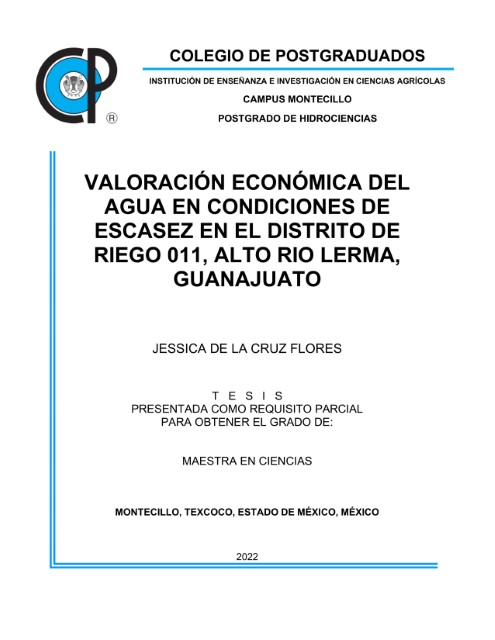
JESSICA DE LA CRUZ FLORES, M. C. Colegio de Postgraduados, 2022.
RESUMEN
En el año 2011 la sequía ocasionó que el 47% del territorio nacional entrara en situación de emergencia por falta de agua, generando pérdidas agrícolas en Guanajuato por 1551.2 millones de pesos, afectando a 123,000 ha y 36,019 productores (CENAPRED, 2012). Este fenómeno se repitió en 2021 con una cobertura del 87% del territorio. En condiciones de sequía debe privilegiarse la planeación del riego con un enfoque de optimización económica, incorporando un valor monetario que refleje el valor de la escasez del agua en función de su disponibilidad y costo de oportunidad. El objetivo de este trabajo fue estimar el valor económico del agua en el Distrito de Riego 011 Alto Rio Lerma, Guanajuato, para el año agrícola 2019-2020, en condiciones de sequía, mediante la asignación óptima del recurso al patrón de cultivos, así como también los escenarios del 25, 50 y 75% de probabilidades de disponibilidad del agua. Se formuló un modelo de Programación Lineal (MPL) (Base) para maximizar el beneficio neto con un patrón de 30 cultivos agrupados en tres ciclos agrícolas, restricciones de agua mensuales y anuales, tierra, mercado y demanda de agua de cultivos. Los resultados indican que con el MPLBase el beneficio neto mejoró en 102.72 millones de pesos y el valor económico del agua en condición de sequía se incrementa 14 veces más (2.52 $/m ) que la tarifa de riego 2019-2020 (0.19 $/m 3 ), valor cada vez menor con mayor disponibilidad de agua. Esto implica que los usuarios deben reconocer el verdadero valor del agua y su inelasticidad en sus costos de producción e iniciar un estudio Técnico- Económico para su implementación.
Palabras clave: disponibilidad de agua, precios sombra, programación lineal, valor económico del agua
ECONOMIC VALUATION OF WATER IN CONDITIONS OF SCARCITY IN THE IRRIGATION DISTRICT 011 ALTO RÍO LERMA, GUANAJUATO.
JESSICA DE LA CRUZ FLORES, M. C. Colegio de Postgraduados, 2022
ABSTRACT
ABSTRACT In 2011, drought caused 47% of the national territory to enter an emergency situation due to lack of water, generating agricultural losses in Guanajuato of 1551.2 million pesos, affecting 123,000 ha and 36,019 producers (CENAPRED, 2012). This phenomenon was repeated in 2021 with a coverage of 87% of the territory. In drought conditions, irrigation planning should be favored with an economic optimization approach, incorporating a monetary value that reflects the value of water scarcity based on its availability and opportunity cost. The objective of this work was to estimate the economic value of water in the Irrigation District 011 Alto Rio Lerma, Guanajuato, for the agricultural year 20192020, under drought conditions, through the optimal allocation of the resource to the crop pattern, as well as the scenarios of 25, 50 and 75% probabilities of water availability. A Linear Programming Model (LPM) (Base) was formulated to maximize the net benefit with a pattern of 30 crops grouped in three agricultural cycles, monthly and annual water restrictions, land, market and crop water demand. The results indicate that with the LPMBase the net benefit improved by 102.72 million pesos and the economic value of water in drought condition increases 14 times more (2.52 $/m ) than the 2019-2020 irrigation rate (0.19 $/m 3 ), decreasing value with increasing water availability. This implies that users must recognize the true value of water and its inelasticity in their production costs and initiate a technical-economic study for its implementation.
Key words: water availability, shadow prices, linear programming, economic value of water.
Fecha: 2022-10
Estudiante: JESSICA DE LA CRUZ FLORES
MAESTRÍA EN CIENCIAS - HIDROCIENCIAS
Consejo Particular:
Consejero: Dr. Adolfo A. Exebio García
Asesor: M.C. Maria Eugenia Delgadillo Piñon
Asesor: Dr. José Saturnino Mora Flores
Asesor: Dr. Juan Enrique Rubiños Panta